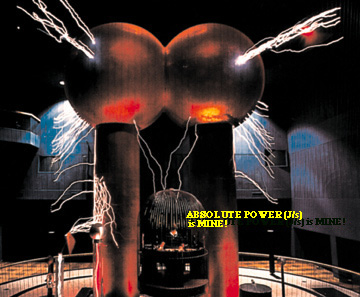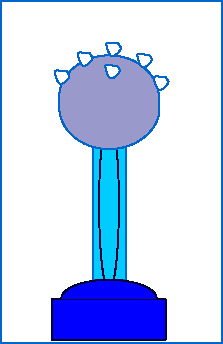![]()
Problem 'o the dayJokeElectricity
|
 |
![]()
A balloon will stick to a wooden wall if the balloon is charged:
a) negatively.
b) positively.
c) either way.
d) neither way.
![]()
In saying that the charged rods/pith balls repel or attract, we really mean that they exert forces on one another.
The negative charge on the metal surface of the pith ball is attracted to the positively-charged glass rod. It moves as close as it can get to it, bringing the pith ball with it. The oppositely charged pieces of tape are observed to move towards each other because of forces on their charges.
Try this experiment with the charged tape (either like or unlike charges). Hold them close enough together so that they just begin to deflect (either away from or towards one another). Now move them closer together. What happens? Why?
(Did the amount of excess charge on the tape change when you did this?)
In this case, "q" is the standard symbol that means "amount of charge (in Coulombs, "C").
The separation is typically stated in meters (m). The constant for these units is:
checkpoint: For two objects with given charges q1 and q2, the force between them will diminish by 1/4 if the separation between the objects is increased by 2.
It turns out that this is exactly analogous to the force between two masses, which we have termed "the force of gravity." For gravity, however, we always are referring to the attraction of an object to the Earth. As the Earth is really quite large, moving small distances above its surface has very little effect on the force (and acceleration) of gravity.
checkpoint: So how are gravity and electrical forces different?
To observe the electric force in action, we can watch what happens when styrofoam balls sitting on top of a Van de Graff generator accumulate excess charge from the generator:

The shiny dome on top of the Van de Graaf generator appears to be made of a special substance. What is it? Why do you suppose it is made out of that?
Charge (electrons in this case) can move easily between metal atoms that are arranged in an orderly lattice. We call this type of material a conductor. Wires are conductors and are usually made of metal.
What about the sticky tape? Is it a good conductor of charge? How could you tell?
Consider two objects, each with an excess of the same type of charge. These two objects will tend to repel each other.
Our rule (tested hypothesis), above, says these two will tend to repel each other. In fact they will repel each other more (with greater force) if the charges are moved closer together.
Imagine pushing one of the "charged" objects towards the other, which is fixed and can not move.
That increase is called electric potential energy. If you let go of the moved object it will want to fly away from the fixed, charged object, converting electric potential energy into kinetic energy.
For two different positions for the moved object-- one close and one further from the fixed, charged object, there would be a difference in electric potential energy.
Voltage depends upon this difference.
Voltage always refers to two separate locations. For example, a "D-cell" nominally provides 1.5 volts between its positive and negative terminals. It doesn't make any sense to refer to the voltage at a single location.
We further define voltage as a difference in potential energies divided by charge:
Our battery voltage source rating tells us how much work it can do on one unit of charge. Think of voltage as the "charge push or pull" that causes charges to accelerate from one side of the voltage source towards the other, usually through a circuit made of wires and other things.
A more technical description says that "a volt is the potential difference necessary to change the energy of 1C (coulomb) of charge by 1J (joule) in moving the charge between two points." (source of quotation: Energy, by G Aubrecht, 1995, Prentice-Hall)
![]()
When like charges undergo a net motion in some specific direction-- e.g., electrons travel along a wire-- a current is said to be flowing. The path that charges follow in being pushed by voltage is called a circuit.
In the absence of very large voltages (potential differences), current needs a "charge highway" (e.g., wire) to travel along. A break in the charge highway, that charges can't be pushed across, results in a broken circuit.
All electrical appliances-- including light bulbs, stereos and televisions, electric heaters and golf carts-- require current flow in order to function. Electric current is measured in units of amperes, defined as:
Electrons in motion comprise the electric currents we use every day. In most metals the nuclei of atoms (protons & neutrons) are bonded together and some of their electrons are relatively free to move around. This is why metals are used to manufacture wire. Placing a voltage across both ends of a wire causes the electrons to accelerate along the wire. They can be pushed through the filament of a lamp and cause something useful to happen-- light!
An idealized voltage source (battery or power plant) is assumed to be a very large resevoir of charge (electrons). The voltage source does work on the electrons to move them, increasing the electron's kinetic energy. When the electrons travel they can do work on other things, giving up their energy gained from the voltage source.
If you could somehow see microscopically inside the filament of a light bulb carrying electric current, you would see electrons accelerating in the direction of current flow. They would occasionally run into the atoms making up the filament, and would be scattered like one pool ball hitting another.
This scattering of electrons reduces their energy and transfers it to the atoms of the filament. The atoms of the filament can be thought of as vibrating from the collision. Some of this energy of vibration would go towards making light. Most would be lost as heat transfer to the surroundings.
![]()
Electrons colliding with atoms amounts to a resistance to their passage through a material.
![]()
As mentioned before, most metals are good conductors of electricity (electrons), so they resist the flow of electrons less than other materials and are used to manufacture pathways for electron flows-- wires. Other materials, e.g. most plastics, ceramics and rubber products are highly resistant to electrons passing through them. These materials are used to clad wires, preventing the electrons from leaking out of the wire or jumping to another wire.
Some poor resistors (good conductors):
Some good resistors (poor conductors):
One analogue for voltage, current flow and resistance is show below:
The green part of this analogous model shows a way to visualize what happens as electrons pass through conducting materials. Marbles on the top have more gravitational potential energy than do those at the bottom. Hence, they roll down the slanted surface. This is analgous with the case of electrons in a wire connected to a battery, which gain electrical potential energy in the battery and "roll" through the wire.
As the marbles roll down, they collide with some of the posts, and lose energy to the posts. The posts vibrate from the collisions. This is analgous to electrons colliding with atoms in a material, losing energy to the atoms, and heating the atoms as a result. The filament of an incandescent heats up following this analogy, and the result is light emission as the atoms cease to vibrate (before the next electron-atom collision).
![]()
A material that has more resistance to the flow of electrons can be thought of as having more posts per area of material. Wires, which have low resistance to electricity (and are called good conductors) have fewer "posts."
![]()
The above analogy falls short in that you might imagine that the marbles would travel faster in the feeder trays (wires) than in the resistive material (light bulb element).
In the case of electricity, the current is the same everywhere in the wire, which means that the same number of electrons are crossing per second at each location along the path. In real circuits, the resistive circuit elements cause traffic jams which propogate backwards (and forwards) along the current path.
Also, don't think that the electrons coming out of one end of a wire are the same ones going in the other end, as is true for our "marble-electrons."
![]()